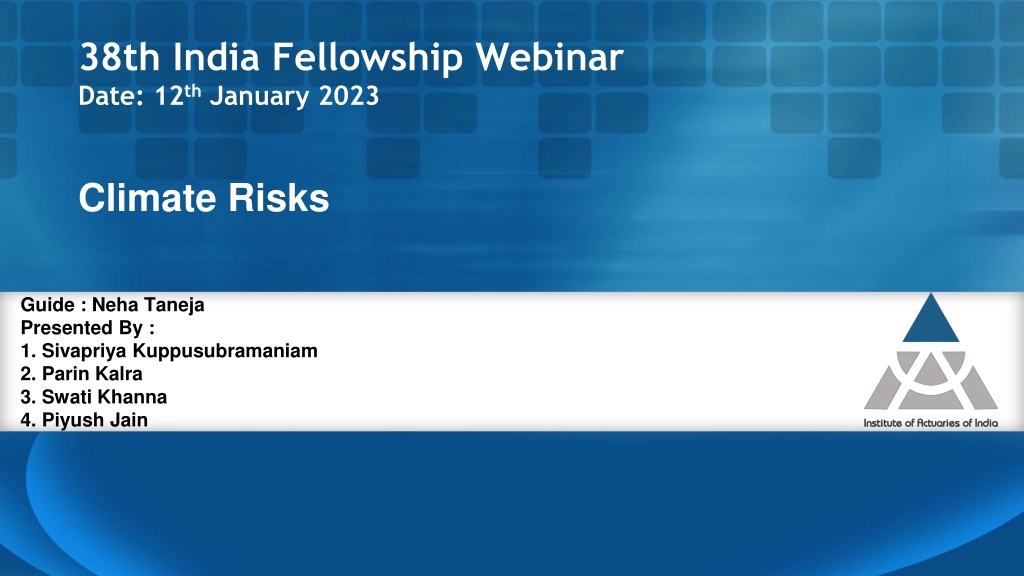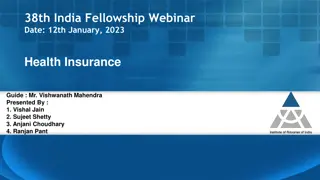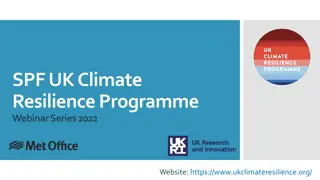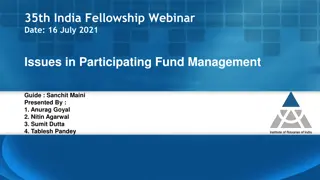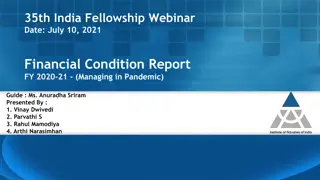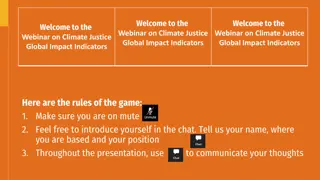Understanding Climate Risks in India: Insights from the 38th India Fellowship Webinar
Explore the impacts of climate risks in India through the lens of physical and transition risks detailed during the 38th India Fellowship Webinar on January 12, 2023. Key topics include climate change interactions, liability risks, and risk management strategies for a sustainable future.
Download Presentation

Please find below an Image/Link to download the presentation.
The content on the website is provided AS IS for your information and personal use only. It may not be sold, licensed, or shared on other websites without obtaining consent from the author. Download presentation by click this link. If you encounter any issues during the download, it is possible that the publisher has removed the file from their server.
E N D
Presentation Transcript
38th India Fellowship Webinar Date: 12th January 2023 Climate Risks Guide : Neha Taneja Presented By : 1. Sivapriya Kuppusubramaniam 2. Parin Kalra 3. Swati Khanna 4. Piyush Jain
Agenda Introduction Overview of Climate Risk Climate Risk - India Interaction of Climate Risk and Other Related risks Climate Change - Risk Management Way Forward Questions? www.actuariesindia.org
Climate risk A result of changes in climate that result in adverse consequences impacting lives, livelihood, health, economy etc. These are broadly categorized as Risks Physical Risk Transition Liability Risks from third parties seeking compensation from the effects of climate change Arises from weather- related events like floods, storms, etc. Risks related to transitioning to a lower carbon economy economic ramifications of damage to infrastructure, supply chain and the built environment that could result in insurance claims potential re-pricing of carbon intensive assets & reduction in premium from carbon intensive sectors Companies being sued because of the impact of their greenhouse gas emissions www.actuariesindia.org
Physical Risk Profile As India is more vulnerable to its diversified climate zones, ecosystem, topography, the risk is expected to be higher in India. Some climate change and its related risks are Droughts and Wildfires Extreme Rainfall Heat Waves Tropical Events Frequency of extreme precipitation events Increase in diseases/ impact on Human Health Increase in duration and intensity Increase in Frequency and Severity changing patterns of atmospheric circulation, Polar icecap melts Damage to Infrastructure and associated business interruption Damage to property and crops Crop Damage, Water Scarcity * The above listed risks are not exhaustive. www.actuariesindia.org
Transition Risk Profile Insurers both side of balance sheet will be impacted Impact on Liability Increase in liability value Impact on Asset Loss of market value Climate Related Risk Unpredictable Risk www.actuariesindia.org
Transition Risk Profile Examples that might impact on general insurers Asset Liability investments in the renewable energy sector Move from fossil fuels withdraw insurance support from projects and companies in the coal sector New/change in manufacturing processes Change in policies and promoting more sustainable land-use practices technological changes - transition to lower-carbon economy Potential latent claims Disruptive changes across economic sectors and industries in the near term (political risks) New emerging risks and increasing uncertainty as countries switch to alternatives such as wind, solar, hydro, geothermal, nuclear, biofuels, etc. www.actuariesindia.org
Liability Risk Profile Insurance companies exposed both through the insurance contracts they write, and through the liability risks to their investments. Increase in climate related litigation claims due to following reasons* Physical through greenhouse gases Impact emissions such as of Failure to mitigate Misleading as not sufficiently disclosing information or not complying with climate change-related legislation or regulation not sufficiently accounted for climate change risk factors in their acts, omissions or decision-making. Increase in Litigation claims Failure to disclose or comply Failure to adapt *As stated by PRA www.actuariesindia.org
Risk/Opportunity for General Insurers Climate change imposes various risk levels and opportunities on the sector from various levels Natural catastrophes claims Indirect impact like disruption of supply chain Higher Losses Greater accumulations of risk/Increased correlation of events Increased weather specific events heatwaves, floods, wildfires Broader shift in climate sea level change, rising average temperature, extreme weather impacting agriculture (e.g. Bumper crops and crop failure) Increase Frequency and Severity Causing civil unrest and inflation Fall in infrastructure and real estate due to rising sea level or extreme weather Falling value of share or debt securities of carbon incentive companies Threat to assets flood prone areas/areas with high climate related events leading to Reduced insurance penetration Widen protection gap Insurance Gap/Less Affordable Affecting underwriting results Green investment strategies leading to lower investments in carbon incentive industries Regulatory restriction of limits of investment in carbon incentive industries Regulatory constraints leading to more than 100% combined ratio Investment in green energy - High set up cost for migrating to renewable energy infrastructure New infrastructure or electric vehicles Opportunities www.actuariesindia.org
Indian Climate risk High-Level Statistics Frequency increased by 24% post-2005 compared to 2005 and prior Extreme CAT events Exposing 42.50 million people (Cyclone only) In the last decade alone, cyclones hit 258 districts Cyclone In two years, 2018 and 19 - Major floods and landslides killed over 700 people and caused USD 11 billion worth of damage 20 times more for flood associated events between 1970 and 2019 At least 55 or more districts witnessed extreme flood events year- on-year, exposing 97.51 million people annually Flood 79 districts recorded extreme drought events year-on-year, exposing 140.06 million people annually Drought www.actuariesindia.org
Change in Cyclone frequency in India These unpredictable and extreme weather events result in greater volatility in company losses, leading to structuring insurance solutions more challenging. Change in Impact in 10 year period Change in Impact in a year period between 2019-20 and 2020-21 is 69% (number of claims reported) www.actuariesindia.org
Climate Risk - India India is one of the most vulnerable countries globally in terms of population that will be affected by sea level rise. By the middle of the century, around 35 million people in India could face annual coastal flooding, with 45-50 million at risk by the end of the century IPCC Working Group www.actuariesindia.org
Indias Climate Risk Profile Diverse climate zones Diverse ecosystems Diverse topography Unevenly distributed climate Risk Alter the distribution and quality of India s natural resources Adversely affect the livelihood of people www.actuariesindia.org
High Confidence Impacts Rise in Sea Levels & Extreme Rainfall Heat Waves, Draughts & Wildfires Changes to Earth's eco-systems Epidemic Heat related diseases (like heat cramps, heat exhaustion, heat syncope, and heat stroke) Vector and water borne diseases (like Malaria, Dengue) Mental Health Issues Air pollution events Damage to property and crops Water Scarcity, Crop damage Circulatory, respiratory diseases Damage to Infrastructure and associated business interruption Decline in fisheries Malnourishment Urbanisation Examples Ahmedabad extremely vulnerable to heat waves, Chennai, Bhubaneswar, Patna & Lucknow at dangerous levels of heat and humidity Examples -Mumbai, Ganga & Brahmaputra basins prone to rise in sea levels and flooding Dietary Shifts *Above list is non-exhaustive www.actuariesindia.org
Macro Level Potential Impact More than 75 per cent of Indian districts, which are home to over 638 million people, are extreme climate event hotspots 9% Fall in production of cereals and pulses@ Price spikes, threatening food affordability, food security Fall in Country s GDP* 3% Carbon Emission Flood-prone areas becoming drought-prone and vice-versa has changed in over 40 per cent of Indian districts Impact on organization s credit profiles/ share prices $86 Increase in country- level cost# @ As per IPCC report in 2050 and 17% for Maze * As IPCC report for low-income countries (assuming India falls under low-income country) by 2050; Damage to Mumbai could be up to $162 billion a year by 2050 # As per IPCC report - per tonne of CO2 emission; www.actuariesindia.org
Interaction between climate risks and other risk categories
Multi-dimensional Climate Risk!! The insurance industry is exposed to climate-related liabilities on two fronts: In both its investments, and on the liability side through property and casualty underwriting. S&P Global Physical Risk Transition Risk Liability Risk Insurance Risk Market Risk Credit Risk Liquidity Risk Operational Risk High Medium Low Medium High High Medium High Medium High- Medium Low - Medium Low Low Medium Low www.actuariesindia.org
Climate Risk and Insurance Risk Insurance Risk Catastrophe Risk Reserve Risk Underwriting Risk Past is not a good guide of future!! www.actuariesindia.org
Climate Risk & Market Risk. Regulatory Interference Climate Risk Stranded Assets Market Risk Market Volatility Increased emphasis on investment return www.actuariesindia.org
Climate Risk and Other Risk Types Credit Risk Reinsurance Default Default on Investments Liquidity Risk Non-green investments Unpredictable claims Increased frequency and severity of catastrophe events Operational Risk Strategic decisions Reputation and Brand Regulatory and Compliance www.actuariesindia.org
Climate Risk framework for Business Decision Need for Framework No single climate change scenario can assess the impact effectively across all firms and across all business decisions No widely accepted process for assessing financial impacts from climate change risk Provide insight to functions such as risk management, underwriting, risk transfer, exposure management, and capital modelling www.actuariesindia.org
Climate Risk framework for Business Decision Implementation of framework - Key considerations What is the relationship between framework stages? comprised of six stages, there may be iterations between stages each stage of activity informs the next stage Does the framework apply to firms of all sizes? stages are generic to make it applicable to most firm types the firm size will inform the emphasis to be given to each of the different stages Who might have responsibility for the framework? an ability to embed the outputs of the framework in the overall firm operations sufficient authority to ensure that the outputs inform decisions www.actuariesindia.org
Climate Risk Management Framework Outline of a sample climate change risk management framework for business decisions Stage 1: Identify the business decision(s) inform a business decision or activity, decide the time horizon and metrics Stage 2: Define Materiality focus on business area with material impact of climate change risk Stage 3: Background research - review existing scientific publications to understand the influence on relevant areas identified Stage 4: Assess available tools select appropriate tool to assess the impact of climate change Stage 5: Calculate impact - using the tools selected to assess the financial impact from the projected changes to the perils. Stage 6: Reporting & action communicate outcome to decision makers highlighting the limitations and uncertainty related to the analysis www.actuariesindia.org
Risk management responses Update the risk management policy of the company to include procedures for identification, measurement, monitoring, managing and reporting exposures to climate related risks Consider capacity building within business. Example - training, guidance, case studies and supporting research with the aim of building carbon literacy Assessing the potential climate change impact for short-, medium- and long-term time horizon, impact on financial viability, future strategy and capital requirement Incorporating climate risk within the risk register including its classification, quantification, potential mitigants and recommended actions Getting out forward looking stress and scenario test to check insurance resilience to physical, transition and liability risk Appropriate disclosures of current and future risk Defining and assessing KPIs to monitor exposure and emerging factors www.actuariesindia.org
ERM key features with potential climate- related risk considerations Governance and ERM Framework Those responsible for governance should ensure that climate related risks are properly considered and assessed in its ERM framework Risk Management Policy Should be flexible to incorporate climate-related risks now and in future Risk Tolerance Statement Explicitly consider climate related risks with regards to investment strategy, or tolerance to demography or other insurance exposure Risk responsiveness and feedback loop Analyse previous experience as well as forward looking emerging risk assessment Scenario Analysis Forward looking view of companies risk exposures and its impact on future business strategy www.actuariesindia.org
Use of Stress/Scenario Analysis To assess Financial viability
Stress/Scenario Analysis Objectives Understand the impacts on an enterprise and its supply chain, business model or program Assess exposure to a combination of complex climate changes Identify risks and opportunities associated with the future ecosystem Test the resilience to more extreme scenarios www.actuariesindia.org
Stress/Scenario Analysis Desirable characteristics Plausible The events described in the scenario should be possible and credible Distinctive Each scenario should be based on a distinct and clearly differentiated set of determinants Consistent Interaction between the qualitative and quantitative elements described in the scenario should obey strong logic Relevant The specific issues at stake should be key to the scenario Challenging The scenarios should challenge the prevailing visions of the future The scenarios should be transparent as to the methods applied, the assumptions made, the reasons behind their choice, the results and the conclusions Transparent www.actuariesindia.org
Stress/Scenario analysis Process www.actuariesindia.org
Climate change Scenarios - Examples Average sea-level rises by 50 cm Annual maximum daily temperature is 2.6 higher Number of hot days increase by 25% Frequency of extreme rainfall increases by 36% Average drought length increase by 4 months Average crop yield for wheat and maize decease by 4% and 9% respectively Sea level rise of approximately 70 cm on average 50% less water availability Very high Heatwave and forest fire risk Risk to marine fisheries and ecosystem plus negative impact on agriculture and food production Increased chances of famine and reduction in food supplies and employment Temperature rises by 2 Temperature rises by 4 www.actuariesindia.org
Some Government Initiatives A report by Climate Transparency said India's actions set under the 2015 Paris climate accord make it compatible to achieve carbon emissions curbs by 2 degrees Celsius. The policies and programs implemented by the government show that environmental protection is one of the central pillars of India s governance framework. Government has planned to move from relief to a prevention, mitigation and preparedness approach As a process, the government has actionable such as enhancing research on climate modelling in India Promoting data access Regulations for local issuance of green bonds www.actuariesindia.org
Next Steps for Actuarial Associations and Individual Actuaries For Actuarial Associations Training and continuing professional development Research and development efforts Regulatory environment For Individual Actuaries Learn about climate- related risks & value of adaptation Be informed Build deeper expertise Collect and share data and techniques Validate the sources of information used Start a dialogue Develop a plan to make this an integrated part of day-to- day work Continuously learn www.actuariesindia.org
References A New Framework for Assessing Climate Change Risk in Financial Markets - Federal Reserve Bank of Chicago (chicagofed.org) Climate-change-report-29072020.pdf (actuaries.org.uk) Practical Guide to Climate Change for GI Practitioners_1.pdf (actuaries.org.uk) A framework for assessing financial impacts of physical climate change - a practitioner's aide for the general insurance sector (bankofengland.co.uk) Introduction to Climate-Related Scenarios (actuaries.org) Importance of Climate-Related Risks for Actuaries Five climate change issues for operational risk scenario analysis - RiskLogix (risklogix-solutions.com) India only country among G20 nations to meet climate change mitigation commitments | India News (timesnownews.com) NAPCC MoEF&CC (cckpindia.nic.in) https://indianpsu.com/physical-climate-risks-for-indias-insurance-sector/ https://reliefweb.int/report/india/climate-risk-country-profile-india Inner 01-54-C 7.6.08 (cckpindia.nic.in) Climate Risk Profile: India | Global Climate Change (climatelinks.org) https://www.irdai.gov.in/admincms/cms/uploadedfiles/annual%20reports/IRDAI%20Annual%20Report%202019-20_English.pdf Template (climatelinks.org) India - G20 Climate Risk Atlas (g20climaterisks.org) India.pdf (cmcc.it) https://www.ipcc.ch/report/ar6/wg2/ https://www.ipcc.ch/report/ar6/wg3/ www.actuariesindia.org
